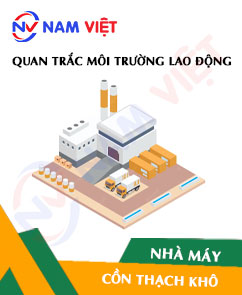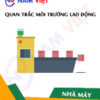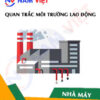Occupational environment monitoring at a solid alcohol manufacturing
99,000 ₫
Note: The above price is calculated for one sample. Prices may vary depending on the area of the environment to be monitored and market fluctuations. For more accurate pricing, please refer to the price list or contact our consulting staff directly.
Monitoring the environment of a solid alcohol production factories involves collecting, analyzing, and evaluating workplace factors that may be harmful to workers health.
Table of Contents
Toggle1. Overview of Solid Alcohol Manufacturing Factories
a. What is a solid alcohol manufacturing factory?
A factory that manufactures solid alcohol, also known as a solid alcohol plant, is a facility that produces solid alcohol from plant-based raw materials such as sugarcane, corn, barley, or other grasses. Solid alcohol is a form of alcohol that has undergone water removal to reduce its water content to about 1%–2% by weight. The production process includes major steps such as crushing, pressing to extract juice from raw materials, fermentation, and distillation.
In a solid alcohol manufacturing factory, plant materials are processed and separated into two main components: alcohol and the remaining residue called post-fermentation mash. The distillation process is then conducted to extract alcohol from the mash. Distillation typically uses multi-stage techniques to improve efficiency and alcohol quality. During distillation in the columns, alcohol vapor rises and is then cooled to crystallize into solid alcohol.
Solid alcohol has various applications, including use in the chemical industry, pharmaceutical production, cosmetics, alcohol production, solvents, and biofuel. Using solid alcohol as a substitute for regular alcohol can reduce carbon emissions and reliance on fossil energy sources.

b. Production stages in a solid alcohol manufacturing factory
The solid alcohol production process in a typical factory includes the following main stages:
- Raw material preparation: The primary raw materials are plants such as sugarcane, corn, barley, or other grasses. They are harvested and transported to the factory for further processing.
- Raw material processing: Plant materials are crushed, chopped, or ground to create a mash that is easy to handle.
- Fermentation: The mash is placed in fermentation tanks and combined with yeast (microorganisms) to carry out fermentation. During this process, microorganisms convert the sugars in the mash into alcohol.
- Distillation: After fermentation, the mixture containing alcohol and water is sent to distillation equipment to separate alcohol from water. Multi-stage distillation columns are commonly used, where alcohol vapor rises through stages and is separated from water.
- Solid alcohol separation: Alcohol vapor from distillation is then cooled to crystallize into solid alcohol. During this process, alcohol solidifies into particles, reducing water content to about 1%–2% by weight.
- By-product processing: The remaining mash, containing residual alcohol and water, can be further processed to extract valuable components such as protein, fiber, or other substances, depending on the raw material and production process.

c. Machinery used in solid alcohol manufacturing factories
Solid alcohol factories use various machines and equipment for production stages. Some common machinery includes:
- Crushing machines: Used to grind and pulverize plant materials into mash for easier processing.
- Pressing systems: Machines and equipment to extract juice from the mash, generating post-fermentation residue.
- Fermentation tanks: Where fermentation occurs, converting sugars in the mash into alcohol using yeast.
- Distillation systems: Including multi-stage distillation columns and related equipment to separate alcohol from the alcohol-water mixture after fermentation. This can be continuous columns or batch distillation systems.
- Cooling machines: Used to cool alcohol vapor from distillation, forming solid alcohol crystals.
- Dryers: Remove remaining water from post-fermentation mash and solid alcohol to ensure low water content.
- Control systems: Devices and automated systems to monitor and control production processes, ensuring efficient and safe operation.

d. Potential occupational diseases for workers in solid alcohol factories
Workers in solid alcohol factories may face certain occupational diseases. Common occupational hazards include:
- Respiratory diseases: Workers may be exposed to alcohol vapors and organic compounds, causing respiratory irritation, bronchitis, pneumonia, and other respiratory issues.
- Skin diseases: Continuous contact with chemicals may cause irritation, dermatitis, mucous membrane inflammation, bleeding skin, and allergic reactions.
- Eye diseases: Exposure to alcohol vapors and chemicals can cause eye irritation, conjunctivitis, and other eye problems.
- Hearing problems: Noise and other sound factors from equipment and machinery may lead to hearing loss or tinnitus.
- Digestive disorders: Exposure to alcohol and other chemicals can lead to gastrointestinal problems such as gastritis, stomach ulcers, and other digestive disorders.
To ensure safety and prevent occupational diseases, solid alcohol factories must comply with labor safety regulations, provide appropriate personal protective equipment, and ensure employee health monitoring and support.

e. Common types of solid alcohol on the market
Solid alcohol, also called dry alcohol, is a form of alcohol with very low water content, usually around 1%–2% by weight. Common types include:
- Industrial solid alcohol: Widely used in chemical industries, as solvents, pharmaceuticals, paints, inks, alcohol production, and other applications. Industrial solid alcohol usually has high alcohol content to meet specific industry requirements.
- Medical solid alcohol: Used in healthcare for sterilization, cleaning skin, cleaning medical instruments, and other hygiene applications. Medical solid alcohol typically contains 70%–90% alcohol, sufficient to kill bacteria and viruses.
- Consumer solid alcohol: Used in consumer products such as perfumes, cosmetics, deodorant sprays, hand sanitizers, and other applications. Consumer solid alcohol usually contains 90%–99% alcohol and is purified for safe use.
- Biofuel solid alcohol: Used as an alternative fuel to replace fossil fuels. It can be applied in internal combustion engines, automobiles, generators, and other biofuel applications.

2. Overview of Occupational Environment Monitoring Services
a. What is occupational environment monitoring in solid alcohol factories?
Occupational environment monitoring (or workplace environment assessment) in a solid alcohol factory involves collecting, evaluating, and analyzing measurements of workplace environmental factors to implement timely measures, minimize harmful effects on worker health, and prevent occupational diseases. Occupational environment monitoring is mandatory for solid alcohol factories.
It plays a critical role in protecting and enhancing worker health, as employees are the primary resource generating profit for a company. Workers frequently exposed to occupational hazards beyond allowed limits may suffer health impacts and occupational diseases.
REGISTER FOR OCCUPATIONAL ENVIRONMENT MONITORING SERVICE
b. An Toan Nam Viet’s occupational environment monitoring program
An Toan Nam Viet’s occupational environment monitoring program is developed by monitoring engineers specializing in labor safety and environmental protection. The program uses modern measurement methods to monitor air, water, microclimate, physical factors, dust, and other elements in the workplace. This program is essential for maintaining a safe working environment and protecting worker health.
Additionally, the program supports research and development of new solutions to improve workplace conditions. With the dedication and professionalism of its monitoring experts, An Toan Nam Viet’s exclusive program represents a breakthrough in labor safety management and environmental protection in Vietnam.

c. Standardization in occupational environment measurement procedures
Standardization in An Toan Nam Viet’s measurement procedures ensures accuracy and reliability of results. The program follows recognized standards and procedures from the Ho Chi Minh City Department of Health. This ensures collected data is reliable for workplace evaluation and guiding improvements to protect worker health.
Standardized procedures are conducted by highly qualified monitoring specialists, allowing managers and experts to trust An Toan Nam Viet’s results and make precise, valuable decisions.
By applying standardized procedures, An Toan Nam Viet demonstrates commitment to a safe work environment and contributes to improving labor safety and environmental management in Vietnam.
d. Reporting occupational environment monitoring results for solid alcohol factories
Monitoring results are prepared according to Form 04, Appendix III issued with Decree 44/2016/ND-CP in two copies: one sent to the workplace that signed the monitoring contract and one retained by the monitoring organization.
Records are stored indefinitely according to legal requirements.

e. Frequency of occupational environment monitoring according to the law
According to Clause 2 of Article 18 of the Law on Occupational Safety and Hygiene 84/2015/QH13, employers must conduct occupational environment monitoring at least once a year to assess harmful factors.
f. Deadline for submitting occupational environment monitoring reports according to the law
The deadline for report submission is before December 31 each year. Enterprises must submit monitoring results to the local Department of Health at the location of the main office and workplaces.
Whenever there are changes in technology, production processes, or upgrades that may introduce new hazardous factors, enterprises must update occupational hygiene records with relevant data for monitoring.
g. Penalties for violations of occupational environment monitoring by employers
According to Article 27 of Decree No. 12/2022/ND-CP dated January 17, 2022, regulating administrative penalties in labor, social insurance, and Vietnamese workers working abroad under contracts:
- Clause 2: Fines from 2,000,000 – 5,000,000 VND for employers who do not publicly inform workers at the monitored workplace and relevant sites about monitoring results immediately after receiving results.
- Clause 3: Fines from 20,000,000 – 40,000,000 VND for employers who fail to conduct occupational environment monitoring to control hazards affecting worker health.
- Clause 4: Fines from 40,000,000 – 60,000,000 VND for employers who collude with monitoring organizations to commit fraud in occupational environment monitoring activities, without reaching the level of criminal liability.
3. Harmful Environmental Factors for Workers in Solid Alcohol Manufacturing Factories
Workers in solid alcohol manufacturing factories may be exposed to several harmful environmental factors. The following are some potential factors that could affect employees’ health:
- Alcohol vapors: Alcohol vapors can irritate the eyes, respiratory system, and skin. Prolonged or improper exposure to alcohol vapors may lead to respiratory problems, pneumonia, and liver issues.
- Chemicals: During solid alcohol production, various chemicals may be used, such as solvents, accelerators, cleaning agents, and other additives. Employees may come into contact with these chemicals through inhalation, skin contact, or ingestion. Exposure can cause irritation, inflammation, toxicity, and other health issues.
- Dust and particles: During the handling and transportation of raw materials, employees may be exposed to dust and particles from plants or other materials. Inhalation of dust and particles can cause respiratory irritation, pneumonia, and other respiratory problems.
- Noise: Machinery and equipment in solid alcohol factories can generate high levels of noise. Continuous and excessive noise may lead to hearing damage, stress, and negatively impact overall health.
- Temperature and humidity: Solid alcohol production processes may create a working environment with high or fluctuating temperatures. Inappropriate temperature and humidity can cause fatigue, dehydration, weaken health, and affect work performance.
REGISTER FOR OCCUPATIONAL ENVIRONMENT MONITORING SERVICE
4. Measures to Improve the Working Environment in Solid Alcohol Factories
Improving the working environment in solid alcohol factories is crucial to protect employees’ health and enhance safety. The following measures can be applied:
- Safety and environmental management system: Ensure that the factory complies with all regulations and rules related to occupational safety and environmental protection. Develop and implement safety policies and work procedures, providing full information and training for employees on safety requirements and preventive measures.
- Chemical management: Review and implement measures to minimize the use of hazardous chemicals and replace them with safer alternatives. Ensure proper storage, handling, and transportation of chemicals. Provide suitable personal protective equipment and train employees in safe chemical usage.
- Adjust work processes: Review and improve production processes to minimize employee exposure to harmful factors such as alcohol vapors, dust, and particles. Ensure proper air circulation and ventilation systems, and provide effective dust extraction equipment.
- Noise control: Provide protective equipment such as noise-canceling earplugs to safeguard employees’ hearing. Evaluate and control noise at the source to minimize its impact on the working environment.
- Regularly conduct occupational environment monitoring in factories to collect and analyze harmful factors affecting workers, then implement adjustments to reduce risks and prevent occupational diseases.
5. Benefits of Periodic Monitoring in Solid Alcohol Factories
An Toan Nam Viet provides businesses with excellent benefits when using occupational environment monitoring services according to Decree 44/2016/NĐ – CP on managing and controlling harmful factors in the workplace affecting employees.
- Businesses can proactively control harmful factors in workshops or factories.
- Receive advice and recommendations to minimize harmful factors and improve workplace environmental quality.
- Indirectly protect human resources, the key factor in business development.
- Reduce the impact of occupational diseases on health, thereby lowering future medical costs.
- Improved employee health leads to higher product quality and ensures consistent production output.
- Ensure compliance with labor safety regulations and avoid legal risks.
- Enhance credibility and professionalism, elevating the company’s brand.
An Toan Nam Viet’s environmental monitoring service is a solution to reduce occupational disease risks, contributing to a clean and high-quality working environment.

6. Nationwide Occupational Environment Monitoring Center
An Toan Nam Viet Occupational Environment Monitoring Center is a professional unit for supervising and measuring occupational environment quality across all provinces in Vietnam. With experienced monitoring specialists, the center uses modern measuring equipment to ensure accuracy and reliability.
In addition to monitoring services, the center supports clients in planning, managing, and tracking workplace environmental issues. With the motto “customer-centric,” the center prioritizes client satisfaction and provides optimal solutions for businesses.
REGISTER FOR OCCUPATIONAL ENVIRONMENT MONITORING SERVICE
With investments in technology, equipment, and workforce, An Toan Nam Viet’s monitoring center has become a reputable unit in occupational environment monitoring in Ho Chi Minh City with the following objectives:
- We value our brand reputation and the quality of our services.
- We provide clients with the best and most suitable solutions.
- Alongside experienced Masters and Engineers, aiming to protect the environment and benefit businesses.
- Clients using An Toan Nam Viet monitoring services receive professional support from experts and the best cost advantages.
The occupational environment monitoring process at An Toan Nam Viet includes the following steps:
- Before monitoring, ensure all equipment is calibrated according to legal regulations.
- Follow the committed occupational environment monitoring procedures with the Department of Health.
- Report monitoring results honestly to employers.
- If results indicate unsafe conditions, An Toan Nam Viet will support remediation measures, and the workplace will:
- Implement measures to improve working conditions, minimizing harmful factor exposure and preventing occupational diseases.
- Organize health check-ups to detect occupational diseases early for employees in unsafe positions.
- Provide material compensation to employees according to labor law regulations.

7. Occupational Environment Monitoring Pricing
To help businesses conduct professional and effective occupational environment monitoring, An Toan Nam Viet provides a detailed price list for monitoring services with quality and reasonable costs.
- Our price list provides detailed information on all monitoring services offered, including costs for travel, measurement, analysis, and reporting. Clients can trust the accuracy and reliability of our monitoring reports.
- We commit to offering competitive and reasonable prices, while providing fast and professional consultation for all monitoring service inquiries.
- With An Toan Nam Viet’s monitoring price list, clients can easily select service packages suitable for their needs, ensuring maximum satisfaction with professional service quality.
No comments yet












Review Occupational environment monitoring at a solid alcohol manufacturing
There are no reviews yet.